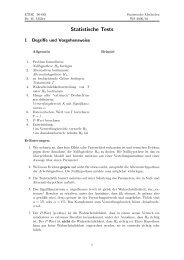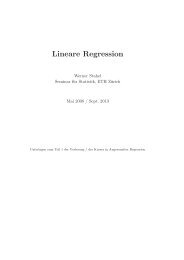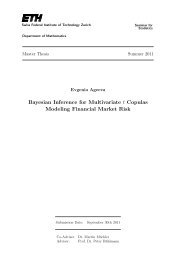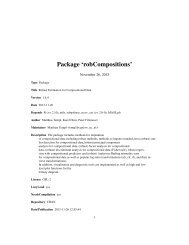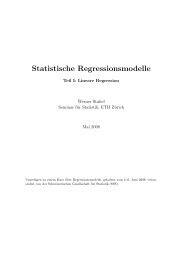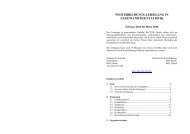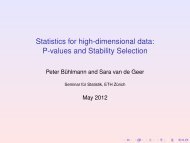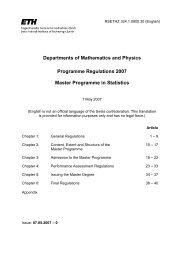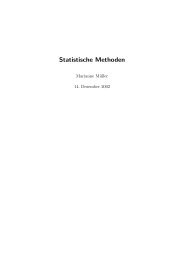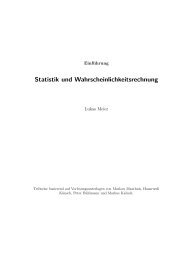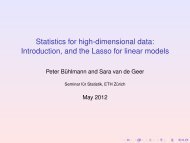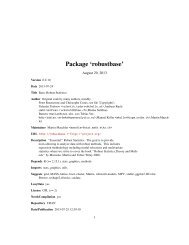Package 'sparr'
Package 'sparr'
Package 'sparr'
- No tags were found...
You also want an ePaper? Increase the reach of your titles
YUMPU automatically turns print PDFs into web optimized ePapers that Google loves.
<strong>Package</strong> ‘sparr’December 10, 2013Type <strong>Package</strong>Title The sparr package: SPAtial Relative RiskVersion 0.3-4Date 2013-12-10Author T.M. Davies, M.L. Hazelton and J.C. MarshallMaintainer Tilman M. Davies Description Provides functions to estimate kernelsmoothedrelative risk functions and perform subsequent inference.Depends R (>= 2.10.1), spatstat, rgl, MASSLicense GPL (>= 2)LazyLoad yesNeedsCompilation noRepository CRANDate/Publication 2013-12-10 07:43:26R topics documented:sparr-package . . . . . . . . . . . . . . . . . . . . . . . . . . . . . . . . . . . . . . . . 2as.im.bivden . . . . . . . . . . . . . . . . . . . . . . . . . . . . . . . . . . . . . . . . . 5bivariate.density . . . . . . . . . . . . . . . . . . . . . . . . . . . . . . . . . . . . . . . 6KBivN . . . . . . . . . . . . . . . . . . . . . . . . . . . . . . . . . . . . . . . . . . . . 11KBivQ . . . . . . . . . . . . . . . . . . . . . . . . . . . . . . . . . . . . . . . . . . . . 12LSCV.density . . . . . . . . . . . . . . . . . . . . . . . . . . . . . . . . . . . . . . . . 13LSCV.risk . . . . . . . . . . . . . . . . . . . . . . . . . . . . . . . . . . . . . . . . . . 15NS . . . . . . . . . . . . . . . . . . . . . . . . . . . . . . . . . . . . . . . . . . . . . . 17OS . . . . . . . . . . . . . . . . . . . . . . . . . . . . . . . . . . . . . . . . . . . . . . 19PBC . . . . . . . . . . . . . . . . . . . . . . . . . . . . . . . . . . . . . . . . . . . . . 201
2 sparr-packageplot.bivden . . . . . . . . . . . . . . . . . . . . . . . . . . . . . . . . . . . . . . . . . 21risk . . . . . . . . . . . . . . . . . . . . . . . . . . . . . . . . . . . . . . . . . . . . . 23summary.bivden . . . . . . . . . . . . . . . . . . . . . . . . . . . . . . . . . . . . . . . 26summary.rrs . . . . . . . . . . . . . . . . . . . . . . . . . . . . . . . . . . . . . . . . . 27tolerance . . . . . . . . . . . . . . . . . . . . . . . . . . . . . . . . . . . . . . . . . . . 27Index 31sparr-packageThe sparr <strong>Package</strong>: SPAtial Relative RiskDescriptionDetailsProvides functions to estimate fixed and adaptive kernel-smoothed relative risk surfaces via thedensity-ratio method and perform subsequent inference.<strong>Package</strong>: sparrVersion: 0.3-4Date: 2013-12-10License: GPL (>= 2)Kernel smoothing, and the flexibility afforded by this methodology, provides an attractive approachto estimating complex probability density functions. This is particularly of interest when exploringproblems in geographical epidemiology, the study of disease dispersion throughout some spatialregion, given a population. The so-called ‘relative risk surface’, constructed as a ratio of estimatedcase to control densities (Bithell, 1990; 1991), describes the variation in the ‘risk’ of the disease,given the underlying at-risk population. This is a technique that has been applied successfully formainly exploratory purposes in a number of different examples (see for example Sabel et al., 2000;Prince et al., 2001; Wheeler, 2007).This package provides functions for bivariate kernel density estimation (KDE), implementing bothfixed and ‘variable’ or ‘adaptive’ (Abramson, 1982) smoothing parameter options (see the functiondocumentation for more information). A selection of bandwidth calculators for bivariate KDE andthe relative risk function are provided, including one based on the maximal smoothing principle(Terrell, 1990), and others involving a leave-one-out least-squares cross-validation (see below).In addition, the ability to construct asymptotically derived p-value surfaces (‘tolerance’ contoursof which signal statistically significant sub-regions of ‘extremity’ in a risk surface - Hazelton andDavies, 2009; Davies and Hazelton, 2010), as well as some flexible visualisation tools, are provided.The content of sparr can be broken up as follows:DatasetsPBC a case/control planar point pattern (ppp) concerning liver disease in northern England. Alsoavailable is the case/control dataset chorley of the spatstat package, which concerns the distributionof laryngeal cancer in an area of Lancashire, England.
sparr-package 3Bandwidth calculatorsOS estimation of an isotropic smoothing parameter for bivariate KDE, based on the oversmoothingprinciple introduced by Terrell (1990).NS estimation of an isotropic smoothing parameter for bivariate KDE, based on the optimal valuefor a normal density (bivariate normal scale rule - see e.g. Wand and Jones, 1995).LSCV.density a least-squares cross-validated (LSCV) estimate of an isotropic bandwidth for bivariateKDE (see e.g. Bowman and Azzalini, 1997).LSCV.risk a least-squares cross-validated (LSCV) estimate of a jointly optimal, common isotropiccase-control bandwidth for the kernel-smoothed risk function (see Kelsall and Diggle, 1995a;b andHazelton, 2008).Bivariate functionsKBivN bivariate normal (Gaussian) kernelKBivQ bivariate quartic (biweight) kernelbivariate.density kernel density estimate of bivariate data; fixed or adaptive smoothingRelative risk and p-value surfacesrisk estimation of a (log) relative risk functiontolerance calculation of asymptotic p-value surfacePrinting and summarising objectsS3 methods (print.bivden, print.rrs, summary.bivden and summary.rrs) are available for thebivariate density and risk function objects.VisualisationMost applications of the relative risk function in practice require plotting the relative risk withinthe study region (especially for an inspection of tolerance contours). To this end, sparr provides anumber of different ways to achieve attractive and flexible visualisation. The user may produce aheat plot, a perspective plot, a contour plot, or an interactive 3D perspective plot (that the user canpan around and zoom - courtesy of the powerful rgl package; see below) for either an estimatedrelative risk function or a bivariate density estimate. These capabilities are available through S3support of the plot function; seeplot.bivden for visualising a single bivariate density estimate from bivariate.density, andplot.rrs for visualisation of an estimated relative risk function from risk.DependenciesThe sparr package depends upon some other important contributions to CRAN in order to operate;their uses here are indicated:spatstat - Fast-fourier transform assistance with fixed and adaptive density estimation, as wellas region handling; see Baddeley and Turner (2005).rgl - Interactive 3D plotting of densities and surfaces; see Adler and Murdoch (2009).MASS - Utility support for internal functions; see Venables and Ripley (2002).
4 sparr-packageCitationTo cite use of sparr in publications, the user may refer to the following work:Davies, T.M., Hazelton, M.L. and Marshall, J.C. (2011), sparr: Analyzing spatial relative riskusing fixed and adaptive kernel density estimation in R, Journal of Statistical Software 39(1), 1-14.Author(s)T.M. DaviesDept. of Mathematics & Statistics, University of Otago, Dunedin, New Zealand;M.L. Hazelton and J.C. MarshallInstitute of Fundamental Sciences - Statistics, Massey University, Palmerston North, New Zealand.Maintainer: T.M.D. Feedback welcomed.ReferencesAbramson, I. (1982), On bandwidth variation in kernel estimates — a square root law, Annals ofStatistics, 10(4), 1217-1223.Adler, D. and Murdoch, D. (2009), rgl: 3D visualization device system (OpenGL). R package version0.87; URL: http://CRAN.R-project.org/package=rglBaddeley, A. and Turner, R. (2005), Spatstat: an R package for analyzing spatial point patterns,Journal of Statistical Software, 12(6), 1-42.Bithell, J.F. (1990), An application of density estimation to geographical epidemiology, Statisticsin Medicine, 9, 691-701.Bithell, J.F. (1991), Estimation of relative risk function,. Statistics in Medicine, 10, 1745-1751.Bowman, A.W. and Azzalini, A. (1997), Applied Smoothing Techniques for Data Analysis: TheKernel Approach with S-Plus Illustrations. Oxford University Press Inc., New York. ISBN 0-19-852396-3.Davies, T.M. and Hazelton, M.L. (2010), Adaptive kernel estimation of spatial relative risk, Statisticsin Medicine, 29(23) 2423-2437.Hazelton, M. L. (2008), Letter to the editor: Kernel estimation of risk surfaces without the need foredge correction, Statistics in Medicine, 27, 2269-2272.Hazelton, M.L. and Davies, T.M. (2009), Inference based on kernel estimates of the relative riskfunction in geographical epidemiology, Biometrical Journal, 51(1), 98-109.Kelsall, J.E. and Diggle, P.J. (1995a), Kernel estimation of relative risk, Bernoulli, 1, 3-16.Kelsall, J.E. and Diggle, P.J. (1995b), Non-parametric estimation of spatial variation in relative risk,Statistics in Medicine, 14, 2335-2342.Prince, M. I., Chetwynd, A., Diggle, P. J., Jarner, M., Metcalf, J. V. and James, O. F. W. (2001),The geographical distribution of primary biliary cirrhosis in a well-defined cohort, Hepatology 34,1083-1088.Sabel, C. E., Gatrell, A. C., Loytonenc, M., Maasiltad, P. and Jokelainene, M. (2000), Modellingexposure opportunitites: estimating relative risk for motor disease in Finland, Social Science &Medicine 50, 1121-1137.Terrell, G.R. (1990), The maximal smoothing principle in density estimation, Journal of the AmericanStatistical Association, 85, 470-477.Venables, W. N. and Ripley, B. D. (2002). Modern Applied Statistics with S, Fourth Edition,
as.im.bivden 5Springer, New York.Wand, M.P. and Jones, C.M., 1995. Kernel Smoothing, Chapman & Hall, London.Wheeler, D. C. (2007), A comparison of spatial clustering and cluster detection techniques forchildhood leukemia incidence in Ohio, 1996-2003, International Journal of Health Geographics,6(13).as.im.bivdenConverting a sparr bivariate kernel density estimate or relative risksurface object into a spatstat pixel image.DescriptionUsageas.im methods for classes "bivden" and "rrs"## S3 method for class bivdenas.im(X, ...)## S3 method for class rrsas.im(X, ...)ArgumentsXValue... Ignored.An object of class "bivden" resulting from a call to bivariate.density, or anobject of class "rss" resulting from a call to risk.An object of class im corresponding to the supplied argument. Additional return information originallypart of X is lost.Author(s)See AlsoT.M. Daviesim, as.imExamplesdata(chorley)ch.bivden
6 bivariate.densitybivariate.densityBivariate kernel density estimatesDescriptionProvides an adaptive or fixed bandwidth kernel density estimate of bivariate data.Usagebivariate.density(data, ID = NULL, pilotH, globalH = pilotH,adaptive = TRUE, edgeCorrect = TRUE, res = 50, WIN = NULL,counts = NULL, intensity = FALSE, xrange = NULL,yrange = NULL, trim = 5, gamma = NULL, pdef = NULL,atExtraCoords = NULL, use.ppp.methods = TRUE, comment = TRUE)ArgumentsdataAn object of type data.frame, list, matrix, or ppp giving the observed datafrom which we wish to calculate the density estimate. Optional ID information(e.g. a dichotomous indicator for cases and controls) may also be providedin these four data structures. See ‘Details’ for further information on how toproperly specify each one.ID If data is a data structure with a third component/column indicating case (1)or control (0) status, ID must specify which of these groups we wish to estimatea density for. If ID is NULL (default), a density is estimated for all presentobservations, regardless of any status information.pilotHglobalHadaptiveedgeCorrectA single numeric, positive ‘smoothing parameter’ or ‘bandwidth’. When adaptiveis TRUE (default), this value is taken to be the pilot bandwidth, used to constructthe bivariate pilot density required for adaptive smoothing (see ‘Details’). Fora fixed bandwidth kernel density estimate, pilotH simply represents the fixedamount of smoothing. Currently, all smoothing is isotropic in nature.A single numeric, positive smoothing multiplier referred to as the global bandwidth,used to calculate the adaptive bandwidths (see ‘Details’). When adaptiveis TRUE, this defaults to be the same as the pilot bandwidth. Ignored for a fixeddensity estimate.Boolean. Whether or not to produce an adaptive (variable bandwidth) densityestimate, with the alternative being a fixed bandwith density estimate. Defaultsto TRUE.Boolean. Whether or not to perform edge-correction on the density estimateaccording to the methods demonstrated by Diggle (1985) (fixed bandwidth) andMarshall and Hazelton (2010) (adaptive). This can have a noticable effect oncomputation time in some cases. Defaults to TRUE. When adaptive = TRUE, thefixed-bandwidth pilot density is also edge-corrected according to edgeCorrect.
ivariate.density 7resWINcountsintensityxrangeyrangetrimgammapdefatExtraCoordsA single, numeric, positive integer indicating the square root of the desired resolutionof the evaluation grid. That is, each of the evaluation grid axes will havelength res. Currently, only res*res grids are supported. Defaults to 50 forcomputational reasons.A polygonal object of class owin from the package spatstat giving the studyregion or ‘window’. All functions in the package sparr that require knowledgeof the specific study region make use of this class; no other method of definingthe study region is currently supported. If no window is supplied (default), thefunction defines (and returns) it’s own rectangular owin based on xrange andyrange. Ignored if data is an object of type ppp.To perform binned kernel estimation, a numeric, positive, integer vector of givingcounts associated with each observed coordinate in data, if data containsunique observations. If NULL (default), the function assumes each coordinate indata corresponds to one observation at that point. Should the data being suppliedto bivariate.density contain duplicated coordinates, the function computesthe counts vector internally (overriding any supplied value for counts),issues a warning, and continues with binned estimation. Non-integer values arerounded to the nearest integer.A boolean value indicating whether or not to return an intensity (interpretedas the the expected number of observations per unit area and integrating to thenumber of observations in the study region) function, rather than a density (integratingto one). Defaults to FALSE.Required only when no study region is supplied (WIN = NULL) and data is notan object of class ppp, and ignored otherwise. A vector of length 2 giving theupper and lower limits of the estimation interval for the x axis, in which case anevenly spaced set of values of length res is generated.As above, but for the y axis.A numeric value (defaulting to 5) that prevents excessively large bandwidthsin adaptive smoothing by trimming the originally computed bandwidths h bytrim times median(h). A value of NA or a negative numeric value requests notrimming. Ignored when adaptive is FALSE.An optional positive numeric value to use in place of gamma for adaptive bandwidthcalculation (see ‘Details’). For adaptive relative risk estimation, this valuecan sensibly be chosen as common for both case and control densities (such asthe gamma value from the adaptive density estimate of the ‘pooled’ (full) dataset)- see Davies and Hazelton (2010). If nothing is supplied (default), this value iscomputed from the data being used to estimate the density in the defined fashion(again, see ‘Details’). Ignored for fixed bandwidth estimation.An optional object of class bivden for adaptive density estimation. This objectis used as an alternative or ‘external’ way to specify the pilot density for computingthe variable bandwidth factors and must have the same grid resolution andcoordinates as the estimate currently being constructed. If NULL (default) thepilot density is computed internally using pilotH from above, but if supplied,pilotH need not be given. Ignored if adaptive = FALSE.It can occasionally be useful to retrieve the values of the estimated density atspecific coordinates that are not the specific observations or the exact grid coordinates,for further analysis or plotting. atExtraCoords allows the user to
8 bivariate.densityDetailsValuespecify an additional object of type data.frame with 2 colums giving the xatExtraCoords[,1] and y atExtraCoords[,2] coordinates at which to calculateand return the estimated density and other statistics (see ‘Value’).use.ppp.methodsBoolean. Whether or not to switch to using methods defined for objects of classppp.object from the package spatstat to estimate the density. This approachis much, much faster than forcing bivariate.density to do the explicit calculations(due to implementation of a Fast Fourier Transform; see density.ppp)and is highly recommended for large datasets. To further reduce computationtime in the adaptive case when use.ppp.methods = TRUE, the variable edgecorrectionfactors are calculated using the integer percentiles of the varyingbandwidths. Defaults to TRUE.commentBoolean. Whether or not to print function progress (including starting and endingtimes) during execution. Defaults to TRUE.This function calculates an adaptive or fixed bandwidth bivariate kernel density estimate, using thebivariate Gaussian kernel. Abramson’s method is used for adaptive smoothing (Abramson, 1982).Suppose our data argumnent is a data.frame or matrix. Then for each observation data[i,1:2](i = 1, 2, ... n), the bandwidth h[i] is given byh[i]=globalH / ( w(data[i,1:2]; pilotH)^(1/2)*gamma )where w is the fixed bandwidth pilot density constructed with bandwidth pilotH and the scalingparameter gamma is the geometric mean of the w^(-1/2) values. A detailed discussion on thisconstruction is given in Silverman (1986).If the data argument is a data.frame or a matrix, this must have exactly two columns containingthe x ([,1]) and y ([,2]) data values, or exactly three columns with the third (rightmost) columngiving ID information by way of a numeric, dichotomous indicator. Should data be a list, thismust have two vector components of equal length named x and y. The user may specify a thirdcomponent with the name ID giving the vector of corresponding ID information (must be of equallength to x and y). Alternatively, data may be an object of class ppp (see ppp.object). ID informationcan be stored in such an object through the argument marks. If data is a ppp object, thevalue of window of this object overrides the value of the argument WIN above.An object of class "bivden". This is effectively a list with the following components:ZmXYkTypea numeric matrix giving the value of the estimated (edge-corrected if elected)density at each of the coordinates of the grid. Values corresponding to points onthe grid that fall outside the study region WIN are set to NAa the sequence of values that were used as x grid coordinates. Will have lengthresa the sequence of values that were used as y grid coordinates. Will have lengthresthe kernel function used in estimation. Currently fixed at "gaus"
ivariate.density 9hpilotHglobalHhypoHzSpeczExtraWINqhzqhzSpecqhzExtrapilotvalsgammacountsdataa numeric vector with length equal to the number of observations, giving thebandwidths assigned to each observation in the order they appeared in data.For a fixed bandwidth estimate, this will simply be the identical value passed toand returned as pilotHthe pilot or fixed bandwidth depending on whether adaptive smoothing is employedor not, respectivelythe global bandwidth globalH if adaptive smoothing is employed, NA for fixedsmoothingthe matrix of ‘hypothetical’ bandwidths (with element placement correspondingto Zm) for each coordinate of the evaluation grid. That is, these values are thebandwidths at that grid coordinate if, hypothetically, there was an observationthere (along with the original data). These are used for edge-correction in adaptivedensities (Marshall and Hazelton, 2010). Will be NA for fixed bandwidthestimatesa numeric vector with length equal to the number of observations used, givingthe values of the density at the specific coordinates of the observations. Ordercorresponds to the order of the observations in dataas zSpec for the observations in atExtraCoords, NA if atExtraCoords is notsuppliedthe object of class owin used as the study regiona numeric matrix of the edge-correction factors for the entire evaluation grid(with placement corresponding to Zm. If edgeCorrect = FALSE, all edge correctionfactors are set to and returned as 1edge-correction factors for the individual observations; order corresponding todataas qhzSpec for the observations in atExtraCoords; NA if atExtraCoords is notsuppliedthe values of the pilot density used to compute the adaptive bandwidths. Ordercorresponds to the order of the observations in data. NULL when adaptive = FALSEthe value of gamma that was passed to the function, or the geometric mean termof the reciprocal of the square root of the pilot density values used to scale theadaptive bandwidths if gamma is not supplied. NULL when adaptive = FALSEthe counts vector used in estimation of the density/intensity. If all values in datawere unique and counts = NULL, the returned counts will be a vector of onesequal to the number of coordinates in dataa two-column numeric data frame giving the observations in the originally supplieddata that were used for the density estimation. If data originally containedduplicated coordinates, the returned data will contain only the uniquecoordinates, and should be viewed with respect to the returned value of countsWarningExplicit calculation of bivariate kernel density estimates is computationally expensive. The decisionto produce adaptive over fixed bandwidth estimates, the size of the dataset, the evaluation gridresolution specified by res, the complexity of the study region and electing to edge-correct all have a
10 bivariate.densitydirect impact upon the time it will take to estimate the density. Keeping use.ppp.methods = TRUEcan drastically reduce this computational cost at the expense a degree of accuracy that is generallyconsidered negligible for most practical purposes.Author(s)T.M. DaviesReferencesAbramson, I. (1982). On bandwidth variation in kernel estimates — a square root law, Annals ofStatistics, 10(4), 1217-1223.Davies, T.M. and Hazelton, M.L. (2010), Adaptive kernel estimation of spatial relative risk, Statisticsin Medicine, 29(23) 2423-2437.Diggle, P.J. (1985), A kernel method for smoothing point process data, Journal of the Royal StatisticalSociety, Series C, 34(2), 138-147.Marshall, J.C. and Hazelton, M.L. (2010) Boundary kernels for adaptive density estimators onregions with irregular boundaries, Journal of Multivariate Analysis, 101, 949-963.Silverman, B.W. (1986), Density Estimation for Statistics and Data Analysis, Chapman & Hall,New York.Examples##Chorley-Ribble laryngeal cancer data (spatstat library)data(chorley)ch.lar.density
KBivN 11KBivNStandard bivariate normal kernelDescriptionEvaluates the standard bivariate normal (Gaussian) kernel function at specified values.UsageKBivN(X)ArgumentsXA numeric vector of length 2 or a data frame with 2 columns.DetailsIf X is a vector of length 2, then the two components X[1] and X[2] are taken to be the x and ycoordinates respectively. For multiple evaluations at differing coordinates, X must be a data framewith X[,1] and X[,2] as the corresponding pairs of x and y coordinates respectively.ValueA single numeric value if X is a vector, or nrow(X) values if X is a data frame, giving the result ofthe standard bivariate normal kernel at the specified coordinate(s).Author(s)T.M. DaviesExamplesKBivN(c(0.1,0.4))x
12 KBivQKBivQStandard bivariate quartic (biweight) kernelDescriptionUsageEvaluates the standard bivariate quartic (biweight) kernel function at specified values, for either thespherical or product derivation of the function.KBivQ(X,type="spher")ArgumentsXtype"spher""prod"A numeric vector of length 2 or a data frame with 2 columns.A character string.(default) selects spherical method of calculating the bivariate quartic kernel functionuses the product approach to calculating the functionDetailsValueIf X is a vector of length 2, then the two components X[1] and X[2] are taken to be the x and ycoordinates respectively. For multiple evaluations at differing coordinates, X must be a data framewith X[,1] and X[,2] as the corresponding pairs of x and y coordinates respectively.Unlike the bivariate Gaussian kernel, it is necessary to specify the method of extending the univariatequartic kernel to the bivariate case; this can be done in two different ways, one way resulting ina slightly different kernel to the other. An explanation of these ‘spherical’ and ‘product’ approachesis given in Wand and Jones (1995).A single numeric value if X is a vector, or nrow(X) values if X is a data frame, giving the result ofthe standard bivariate quartic kernel at the specified coordinate(s) for the elected function derivationtype.Author(s)T.M. DaviesReferencesWand, M.P. and Jones, C.M. (1995), Kernel Smoothing, Chapman & Hall, London.ExamplesKBivQ(c(0.1,0.4))
LSCV.density 13x
14 LSCV.densitycommentBoolean. Whether or not to print function progress during execution. Defaultsto TRUE.DetailsValueThis function calculates a LSCV smoothing bandwidth for kernel density estimates of 2-dimensional(bivariate) data. If the data argument is a data.frame or a matrix, this must have exactly twocolumns containing the x ([,1]) and y ([,2]) data values. Should data be a list, this must havetwo vector components of equal length named x and y. Alternatively, data may be an object ofclass ppp (see ppp.object).A single numeric value of the estimated bandwidth (if quick = FALSE, this value is named hopt;additionally returned are the objective function values (lscv) and the index of the minimum value(ind)). The user may need to experiment with adjusting hlim to find a suitable minimum.WarningLeave-one-out LSCV for bandwidth selection in kernel density estimation is notoriously unstablein practice and has a tendency to produce rather small bandwidths. Satisfactory bandwidths are notguaranteed for every application. This method can also be computationally expensive for large datasets and fine evaluation grid resolutions.Author(s)T.M. DaviesReferencesBowman, A.W. and Azzalini, A. (1997), Applied Smoothing Techniques for Data Analysis: TheKernel Approach with S-Plus Illustrations. Oxford University Press Inc., New York. ISBN 0-19-852396-3.Stoyan, D. and Stoyan, H. (1994), Fractals, Random Shapes and Point Fields. Wiley, Great Britain.ISBN 0-471-93757-6.See Alsospatstat’s function bw.relriskExamples## Not run:data(PBC)##PBC casesLSCV.density(split(PBC)[[1]],hlim=c(10,400))
LSCV.risk 15##PBC controlsLSCV.density(split(PBC)[[2]],hlim=c(10,400))## End(Not run)LSCV.riskLeave-one-out least-squares cross-validation (LSCV) bandwidths forthe relative risk functionDescriptionAttempts to estimate a jointly optimal, common case-control fixed bandwidth for use in the kernelsmoothedrelative risk function via leave-one-out least-squares cross-validation (LSCV). The usercan choose between two methods described in Kelsall and Diggle (1995a;b) and Hazelton (2008).UsageLSCV.risk(cases, controls, hlim = NULL,method = c("kelsall-diggle", "hazelton"), res = 128,WIN = NULL, edge = TRUE, comment = TRUE)ArgumentscasescontrolshlimmethodresWINedgecommentAn object of type data.frame, list, matrix, or ppp describing the observedcase data from which we wish to calculate the LSCV bandwidth. See ‘Details’for further information.As for cases, but for the control observations. Both cases and controls mustbe of the same object class.A numeric vector of length 2 giving the interval over which to search for thecommon bandwidth which minimises the selection criterion. If NULL (default),the function attempts to automatically select an appropriate range based on multiplesof Stoyan and Stoyan’s (1994) rule-of-thumb. The user is strongly recommendedto supply their own hlim.A character vector giving the specific selection criterion to minimise; see eitherKelsall and Diggle (1995b) or Hazelton (2008). See ‘Details’. Defaults to"kelsall-diggle".Single integer giving the square grid resolution over which evaluation of theselection criterion takes place. Defaults to a 128 by 128 grid.A polygonal owin object giving the study region. Ignored if data is already appp.object.Boolean. Whether or not to employ edge-correction in the calculations. Defaultsto TRUE.Boolean. Whether or not to print function progress during execution. Defaultsto TRUE.
16 LSCV.riskDetailsThis function calculates a ‘jointly optimal’, common isotropic LSCV bandwidth for the (Gaussian)kernel-smoothed relative risk function (case-control density-ratio). If the cases, controls argumentsare data.frame or matrix objects, these must each have exactly two columns containing thex ([,1]) and y ([,2]) data values. Should they be lists, these must have two vector componentsof equal length named x and y. Alternatively, cases and controls may be objects of class ppp (seeppp.object), and the argument WIN can be ignored.It can be shown that choosing a bandwidth that is equal for both case and control density estimatesis preferable to computing ‘separately optimal’ bandwidths (Kelsall and Diggle, 1995a). Settingmethod = "kelsall-diggle", LSCV.risk computes the common bandwidth which minimisesthe approximate mean integrated squared error of the log-transformed risk surface (see specificallyKelsall and Diggle, 1995b).Alternatively, the user has the option of computing the common case-control bandwidth which minimisesa weighted mean integrated squared error of the (raw) relative risk function (see Hazelton,2008). Generally, this author has found the Kelsall-Diggle method to provide more stable performance.ValueA single numeric value of the estimated bandwidth. The user may need to experiment with adjustinghlim to find a suitable minimum.WarningLeave-one-out LSCV for jointly optimal, common bandwidth selection in the kernel-smoothed riskfunction is even more unstable (in terms of high variability) than the standalone density version.Caution is advised; not all applications will yield a successful result (this is termed “a breakdown ofthe methodology” by Kelsall and Diggle, 1995a). Undersmoothing has been noted in this author’spersonal experience. This method can also be computationally expensive for large data sets and fineevaluation grid resolutions.Author(s)T.M. DaviesReferencesKelsall, J.E. and Diggle, P.J. (1995a), Kernel estimation of relative risk, Bernoulli, 1, 3-16.Kelsall, J.E. and Diggle, P.J. (1995b), Non-parametric estimation of spatial variation in relativerisk, Statistics in Medicine, 14, 2335-2342.Hazelton, M. L. (2008), Letter to the editor: Kernel estimation of risk surfaces without the needfor edge correction, Statistics in Medicine, 27, 2269-2272.
NS 17Stoyan, D. and Stoyan, H. (1994), Fractals, Random Shapes and Point Fields. Wiley, Great Britain.ISBN 0-471-93757-6.See Alsospatstat’s function bw.relriskExamples## Not run:data(chorley)LSCV.risk(cases = split(chorley)[[1]], controls = split(chorley)[[2]],hlim = c(0.1,2))## End(Not run)NSNormal scale rule for bivariate KDE bandwidthsDescriptionProvides the (isotropic) optimal bandwidth for a bivariate normal density based on a simple expression.UsageNS(data, nstar = NULL, scaler = NA)ArgumentsdatanstarscalerAn object of type data.frame, list, matrix, or ppp giving the observed datafrom which we wish to calculate the NS bandwidth. See ‘Details’ for furtherinformation.A single numeric, positive value to use in place of the number of observations nin the NS formula. If NULL (default), n will simply be the number of observationsin data.A single numeric, positive value to use for transforming the result with respectto the scale of the recorded data (i.e. a scalar representation of the standarddeviation of the data). If NA (default), the scaling value is set as the mean of theinterquartile ranges (IQR) of the x and y data values divided by 1.34 (GaussianIQR).
18 NSDetailsThis function calculates a smoothing bandwidth for kernel density estimates of 2-dimensional data:the optimal value which would minimise the asymptotic mean integrated squared error of the bivariatenormal density function, assuming the standard Gaussian kernel function. See Wand and Jones(1995) for example. If the data argument is a data.frame or a matrix, this must have exactly twocolumns containing the x ([,1]) and y ([,2]) data values. Should data be a list, this must havetwo vector components of equal length named x and y. Alternatively, data may be an object ofclass ppp (see ppp.object).ValueA single numeric value of the estimated bandwidth.WarningThe NS bandwidth is an approximation, and assumes that the target density is bivariate normal.This is considered rare in e.g. epidemiological applications. Nevertheless, it remains a quick andeasy ‘rule-of-thumb’ method with which one may obtain a smoothing parameter in general applications.Author(s)T.M. DaviesReferencesWand, M.P. and Jones, C.M., 1995. Kernel Smoothing, Chapman & Hall, London.Examplesdata(PBC)PBC.casedata
OS 19OSMaximal smoothing principle (oversmoothing) for bivariate KDEbandwidthsDescriptionProvides an (isotropic) bandwidth estimate for use in bivariate KDE based on the oversmoothingfactor introduced by Terrell (1990).UsageOS(data, nstar = NULL, scaler = NA)ArgumentsdatanstarscalerAn object of type data.frame, list, matrix, or ppp giving the observed datafrom which we wish to calculate the OS bandwidth. See ‘Details’ for furtherinformation.A single numeric, positive value to use in place of the number of observations nin the OS formula. If NULL (default), n will simply be the number of observationsin data.A single numeric, positive value to use for transforming the result with respectto the scale of the recorded data. If NA (default), the scaling value is set as themean of the interquartile ranges (IQR) of the x and y data values divided by 1.34(Gaussian IQR). This approach was used in Davies and Hazelton (2010).DetailsThis function calculates a smoothing bandwidth for kernel density estimates of bivariate data, followingthe maximal smoothing priciple of Terrell (1990). If the data argument is a data.frameor a matrix, this must have exactly two columns containing the x ([,1]) and y ([,2]) data values.Should data be a list, this must have two vector components of equal length named x and y.Alternatively, data may be an object of class ppp (see ppp.object).ValueA single numeric value of the estimated bandwidth.Author(s)T.M. Davies
20 PBCReferencesDavies, T.M. and Hazelton, M.L. (2010), Adaptive kernel estimation of spatial relative risk, Statisticsin Medicine, 29(23) 2423-2437.Terrell, G.R. (1990), The maximal smoothing principle in density estimation, Journal of the AmericanStatistical Association, 85, 470-477.Examplesdata(PBC)PBC.casedata
plot.bivden 21SourcePrince et al. (2001), The geographical distribution of primary biliary cirrhosis in a well-definedcohort, Hepatology, 34, 1083-1088.ReferencesDavies, T.M. and Hazelton, M.L. (2010), Adaptive kernel estimation of spatial relative risk, Statisticsin Medicine, 29(23) 2423-2437.Examplesdata(PBC)summary(PBC)plot(PBC)plot.bivdenPlotting a bivariate kernel density estimate objectDescriptionplot methods for classes "bivden" and "rrs"Usage## S3 method for class bivdenplot(x, ..., display = c("heat", "contour", "persp", "3d"),show.WIN = TRUE)## S3 method for class rrsplot(x, ..., display = c("heat", "contour", "persp", "3d"),show.WIN = TRUE, tolerance.matrix = NULL,tol.opt = list(raise = 0.01, col = "black", levels = 0.05, lty = 1, lwd = 1))ArgumentsxAn object of class "bivden" resulting from a call to bivariate.density, or anobject of class "rss" resulting from a call to risk.... Additional graphical parameters to be passed to the relevant plot command dependingon the value of display.displayshow.WINOne of four possible character strings indicating the kind of plot desired (see’Details’). Defaults to "heat".Boolean. Whether or not to draw the study region as an aesthetic enhancementto the plot of the density/risk surface. Defaults to TRUE.
22 plot.bivdenDetailsValuetolerance.matrixThe matrix of p-values resulting from a call to tolerance and used to draw theasymptotic tolerance contours. If this argument is supplied, tolerance contoursare automatically superimposed upon a display = "heat" or display = "3d"plot. Ignored for display = "persp" or display = "contour" plots. Defaultsto NULL.tol.optA named list of components that control plotting of the tolerance contours givenby tolerance.matrix. Components col, levels, lty and lwd are vectors ofequal length controlling the colour, significance levels, line type (ignored fordisplay = "3d") and line width of the plotted contours respectively. The elementraise is a single numeric value and is used only when display = "3d".This vertically (i.e. with respect to the z axis) translates the contours upon the3-D surface (see ‘Details’). A value of 0 requests no translation. Defaults to0.01.There are currently four implemented plot types to visualise the estimated density or risk function."heat" selects a heatplot, "contour" is simply a contour plot and "persp" creates a perspectiveplot. Selection of "3d" uses functions from the rgl package to open an RGL graphics device andcreates a 3-dimensional surface which the user can interact with using the mouse. To use ... toimprove the appearance of the four possible plot types "heat", "contour", "persp" and "3d", thereader is highly recommended to consult the relevant documentation in the help pages plot.im,contour, persp and persp3d respectively.Adding tolerance contours to a "3d" relative risk plot requires the function to make some approximationsto the vertical positioning of the contours at each corresponding coordinate. This can leadto some parts of normally visible contours falling ‘underneath’ the plotted surface, resulting in partiallyobscured contours. The element raise in tol.opt overcomes this issue by artificially raisingthe visible contours by a fixed amount. Care should be taken to find an appropriate value for raisefor each analysis.Plots to the relevant graphics device.Author(s)See AlsoT.M. Daviesbivariate.density, risk, plot.default, plot.im, contour,persp, persp3d, par, par3dExamples## see Examples in documentation for functions bivariate.density,## risk and tolerance.
isk 23riskBivariate relative risk functionDescriptionEstimates a relative risk function based on the ratio of two bivariate kernel density estimates overidentical grids and regions. In geographical epidemiology, the two densities would represent a set ofdisease cases (numerator) and a sample of controls illustrating the at-risk population (denominator).In epidemiological terminology, the ratio of ‘case’ to ‘control’ would technically be referred to asan odds ratio.Usagerisk(f, g, delta = 0, log = TRUE, h = NULL, adaptive = FALSE, res = 50,WIN = NULL, tolerate = FALSE, plotit = TRUE, comment = TRUE)ArgumentsfgdeltaloghadaptiveEither a pre-calculated object of class "bivden" representing the ‘case’ densityestimate, or an object of type data.frame, list, matrix, or ppp giving theobserved case data. If this raw data is provided, a kernel density estimate is computedinternally, with certain options available to the user in bivariate.densitychosen/calculated automatically. See ‘Details’ for further information.As for argument f, but for the controls. Whatever the type, the class of g mustmatch that of f.A single numeric scaling parameter used for an optional additive constant tothe densities; occasionally used for risk surface construction (see ‘Details’). Anegative or zero value for delta requests no additive constant (default).Boolean. Whether or not to return the (natural) log-transformed relative riskfunction as recommended by Kelsall and Diggle (1995a). Defaults to TRUE withthe alternative being the raw density ratio.Ignored if f and g are already "bivden" objects. An optional numeric vectorof length 1 OR 2, giving the global bandwidth(s) for internal estimation ofthe case and control densities if adaptive = TRUE, or the fixed bandwidth(s)if adapative = FALSE. When h is a single numeric value, this is elected asthe common global/fixed bandwidth for case and control densities. When hhas length 2, the values h[1] and h[2] are assigned as the case and controlglobal/fixed bandwidths respectively. By default, a value of h = NULL tells thefunction to use the global/fixed smoothing parameters as outlined in ‘Details’below. Note that for adaptive estimation, this argument does not affect calculationof the pilot bandwiths.Ignored if f and g are already "bivden" objects. A boolean value specifyingwhether or not to employ adaptive smoothing for internally estimating the densities.A value of FALSE (default) elects use of fixed-bandwidth estimates.
24 riskresWINtolerateplotitcommentIgnored if f and g are already "bivden" objects. A numeric value giving thedesired resolution (of one side) of the evaluation grid. Higher values increaseresolution at the expense of computational efficiency. Defaults to a 50 by 50grid.Ignored if f and g are already "bivden" objects OR objects of class ppp (inwhich case the study region is set to the value of the resident window component).A polygonal object of class owin giving the relevant study region in whichthe f and g data was collected.Ignored if f and g are already "bivden" objects. A boolean value specifyingwhether or not to calculate a corresponding asymptotic p-value surface (for tolerancecontours) for the estimated relative risk function. If TRUE, the p-valuesurface tests for elevated risk only (equivalent to setting test = "greater"in tolerance) and is evaluated over a maximum grid resolution of 50 by 50.Defaults to FALSE for computational reasons.Boolean. If TRUE (default), a heatplot of the estimated relative risk function isproduced. If tolerate = TRUE, asymptotic tolerance contours are automaticallyadded to the plot at a significance level of 5%.Ignored if f and g are already "bivden" objects. Boolean. Whether or not toprint function progress (including starting and ending date-times) during execution.Defaults to TRUE.DetailsThis function estimates a relative risk function via the density ratio method using fixed or adaptivebandwidth bivariate kernel density estimates. Both densities must be estimated using the same evaluationgrid (and the same study window) in bivariate.density. In geographical epidemiology,the argument f represents the spatial distribution of the disease cases, and g the at-risk (control)population.The option to supply the raw case and control data is available. If this is done, the function runsbivariate.density internally, abstracting certain decisions about the density estimation awayfrom the user. If the user sets adaptive = TRUE (and h remains at NULL), the smoothing parametersare calculated as per the approach taken in Davies and Hazelton (2010): a common global bandwidthusing the pooled data from OS. Pilot bandwidths are set at half the corresponding OS values.The scaling parameter gamma is common for the case and control density estimates, set as the gammacomponent of the pooled estimate. If a fixed relative risk is desired (adaptive = FALSE) and nospecific bandwidths are given via the argument h, the case and control densities share a commonbandwidth computed from the pooled data using OS. In supplying raw data to risk, the user mustalso specify an evaluation grid resolution (defaulting to 50 by 50) and the study region WIN (unlessf and g are objects of class ppp, in which case the resident window component overrides WIN). Allother arguments are set to their defaults as in bivariate.density.If more flexibility is required for estimation of the case and control densities, the user must supply‘pre-calculated’ objects of class "bivden" (from bivariate.density) as the f and g arguments.This drastically reduces the running time of a call to risk (as the density estimation step is alreadycomplete). However, the option of internally computing the asymptotic p-value surfaces (via theargument tolerate) is unavailable in this case; the user must run the tolerance function separatelyif tolerance contours are desired.
isk 25ValueThe relative risk function is defined here as the ratio of the ‘case’ density to the ‘control’ (Bithell,1990; 1991). Using kernel density estimation to model these densities (Diggle, 1985), we obtain aworkable estimate thereof. This function defines the risk function r in the following fashion:r = (f + delta*max(g))/(g + delta*max(g))Note the (optional) additive constants defined by delta times the maximum of each of the densitiesin the numerator and denominator respectively (see Bowman and Azzalini, 1997).The log-risk function rho, given by rho = log[r], is argued to be preferable in practice as it impartsa sense of symmetry in the way the case and control densities are treated (Kelsall and Diggle,1995a;b). The option of log-transforming the returned risk function is therefore selected by default.An object of class "rrs". This is a marked list with the following components:rsMfglogpooledPa numeric res*res matrix (where res is the grid resolution as specified in thecalls to bivariate.density for calculation of f and g) giving the values of therisk surface over the evaluation grid. Values corresponding to grid coordinatesoutside the study region are assigned NAthe object of class "bivden" used as the numerator or ‘case’ density estimatethe object of class "bivden" used as the denominator or ‘control’ density estimatewhether or not the returned risk function is on the log-scalethe object of class "bivden" (based on the pooled data) calculated internally iff and g were raw data arguments, NA otherwisea numeric 50 by 50 matrix of the asymptotic p-value surface if tolerate = TRUEand f and g were raw data arguments, NA otherwiseWarningIf raw data is supplied to risk, as opposed to previously computed objects of class "bivden",the running time of this function will be greater. This is particularly the case if the user has alsoselected tolerate = TRUE. In the same fashion as bivariate.density and tolerance, settingcomment = TRUE can keep the user appraised of the function progress during run-time.Author(s)T.M. Davies, M.L. Hazelton and J.C. MarshallReferencesBithell, J.F. (1990), An application of density estimation to geographical epidemiology, Statisticsin Medicine, 9, 691-701.Bithell, J.F. (1991), Estimation of relative risk functions, Statistics in Medicine, 10, 1745-1751.Bowman, A.W. and Azzalini A. (1997), Applied Smoothing Techniques for Data Analysis: The
26 summary.bivdenKernel Approach with S-Plus Illustrations, Oxford University Press Inc., New York.Davies, T.M. and Hazelton, M.L. (2010), Adaptive kernel estimation of spatial relative risk, Statisticsin Medicine, 29(23) 2423-2437.Diggle, P.J. (1985), A kernel method for smoothing point process data, Journal of the Royal StatisticalSociety Series C, 34(2), 138-147.Kelsall, J.E. and Diggle, P.J. (1995a), Kernel estimation of relative risk, Bernoulli, 1, 3-16.Kelsall, J.E. and Diggle, P.J. (1995b), Non-parametric estimation of spatial variation in relativerisk, Statistics in Medicine, 14, 2335-2342.Examples## Not run:data(PBC)PBC.casedata
summary.rrs 27Argumentsx, object An object of class "bivden".... Ignored.Author(s)T.M. Daviessummary.rrsSummarising an estimated relative risk function objectDescriptionUsageprint and summary methods for class "rrs"## S3 method for class rrsprint(x, ...)## S3 method for class rrssummary(object, ...)Argumentsx, object An object of class "rrs" resulting from a call to risk.... Ignored.Author(s)T.M. DaviestoleranceAsymptotic p-value surfacesDescriptionUsageCalculates pointwise p-values based on asymptotic theory or Monte-Carlo (MC) permutations describingthe extremity of risk over a given fixed or adaptive kernel-smoothed relative risk function.tolerance(rs, pooled, test = "upper",method = "ASY", reduce = 1, ITER = 1000,exactL2 = TRUE, comment = TRUE)
28 toleranceArgumentsrspooledtestmethodreduceITERexactL2commentAn object of class "rrs" resulting from a call to risk, giving the fixed or adaptivekernel-smoothed risk function.An object of class "bivden" resulting from a call to bivariate.density (orthe component pooled from rs if it was created using raw data arguments)representing a density estimate based on the ‘pooled’ dataset of both ‘case’ and‘control’ points. If separate from rs, this pooled density estimate must followthe same smoothing approach, evaluation grid and study region window as thedensities used to create rs.A character string indicating the kind of test desired to yield the p-values. Mustbe one of "upper" (default - performs upper tailed tests examining heightedrisk ‘hotspots’), "lower" (lower tailed tests examining ‘troughs’) or "double"(double-sided tests). See ‘Details’ for further information.A character string, either "ASY" (default) or "MC" indicating which method touse for calculating the p-value surface (asymptotic and Monte-Carlo approachesrespectively). The MC approach is far more computationally expensive than theasymptotic method (see ‘Warnings’).A numeric value greater than zero and less than or equal to one giving theuser the option to reduce the resolution of the evaluation grid for the pointwisep-values by specifying a proportion of the size of the evaluation grid forthe original density estimates. For example, if the case and control "bivden"objects were calculated using res = 100 and tolerance was called withreduce = 0.5, the p-value surface will be evaluated over a 50 by 50 grid.A non-integer value resulting from use of reduce will be ceilinged.An integer value specifying the number of iterations to be used if method = "MC"(defaulting to 1000). Non-integer numeric values are rounded. Ignored whenmethod = "ASY".Ignored if rs (and pooled) are fixed-bandwidth density estimates, or if method = "MC".A boolean value indicating whether or not to separately calculate the ‘L2’ integralcomponents for adaptive tolerance contours. A value of FALSE will approximatethese components based on the ‘K2’ integrals for faster execution(depending on the size of the evaluation grid, this improvement may be small)at the expense of a small degree of accuracy. Defaults to TRUE. See the referencefor adaptive p-value surfaces in ‘Details’ for definitions of these integralcomponents.Boolean. Whether or not to print function progress (including starting and endingtimes) during execution. Defaults to TRUE.DetailsThis function implements developments in Hazelton and Davies (2009) (fixed) and Davies andHazelton (2010) (adaptive) to compute pointwise p-value surfaces based on asymptotic theory ofkernel-smoothed relative risk surfaces. Alternatively, the user may elect to calculate the p-valuesurfaces using Monte-Carlo methods (see Kelsall and Diggle, 1995). Superimposing upon a plotof the risk surface contours of these p-values at given significance levels (i.e. ‘tolerance contours’)can be an informative way of exploring the statistical significance of the extremity of risk across the
tolerance 29defined study region. The asymptotic approach to the p-value calculation is advantageous over aMonte-Carlo method, which can lead to excessive computation time for adaptive risk surfaces andlarge datasets. See the aforementioned references for further comments.Choosing different options for the argument test simply manipulates the ‘direction’ of the p-values.That is, plotting tolerance contours at a significance level of 0.05 for a p-value surface calculatedwith test = "double" is equivalent to plotting tolerance contours at significance levels of 0.025and 0.975 for test = "upper".ValueA list with four components:XYZPthe equally spaced sequence of length ceiling(reduce*res) giving the evaluationlocations on the x axis (where res is the grid resolution as specified in thecalls to bivariate.density for calculation of the densities for rs and pooled)as above, for the y axisa numeric ceiling(reduce*res)*ceiling(reduce*res) matrix giving the valuesof the risk surface over the evaluation grid. Values corresponding to gridcoordinates outside the study region are assigned NA. If method = "MC", thiswill be a single value of NAa ceiling(reduce*res)*ceiling(reduce*res) matrix giving the p-valuescorresponding to the evaluation grid in light of the elected testWarningThough far less expensive computationally than calculation of Monte-Carlo p-value surfaces, theasymptotic p-value surfaces (particularly for adaptive relative risk surfaces) can still take sometime to complete. The argument of reduce provides an option to reduce this computation timeby decreasing the resolution of the evaluation grid. However, the accuracy and appearance of theresulting tolerance contours can be severely degraded if reduce is assigned too small a value. Caremust therfore be taken and consideration given to the resolution of the original evaluation gridwhen altering reduce from its default value. For most practical purposes, we have found a value ofreduce resulting in evaluation of a p-value surface of size 50 by 50 is adequate.The MC approach is provided as an option here for the sake of completeness only, and is codedexclusively in R. The computational cost of this approach for the adaptive risk function is enoughto recommend against its use in this case, though it is faster for the fixed-bandwidth case if justcomparing MC execution times between the two smoothing regimens. Comments on the issue ofMC vs ASY are given in Section 3 of Hazelton and Davies (2009).Author(s)T.M. Davies and M.L. HazeltonReferencesKelsall, J.E. and Diggle, P.J. (1995), Kernel estimation of relative risk, Bernoulli, 1, 3-16.
30 toleranceDavies, T.M. and Hazelton, M.L. (2010), Adaptive kernel estimation of spatial relative risk, Statisticsin Medicine, 29(23) 2423-2437.Hazelton, M.L. and Davies, T.M. (2009), Inference based on kernel estimates of the relative riskfunction in geographical epidemiology, Biometrical Journal, 51(1), 98-109.Examples## Not run:data(chorley)ch.h
Index∗Topic datasetsPBC, 20∗Topic packagesparr-package, 2as.im, 5as.im.bivden, 5as.im.rrs (as.im.bivden), 5bivariate.density, 3, 5, 6, 21–25, 28, 29bivden (bivariate.density), 6bw.relrisk, 14, 17chorley, 2contour, 22data.frame, 6, 8, 13–19, 23density.ppp, 8im, 5KBivN, 3, 11KBivQ, 3, 12plot.im, 22plot.rrs, 3plot.rrs (plot.bivden), 21ppp, 2, 6–8, 13–19, 23, 24ppp.object, 8, 13–16, 18–20print.bivden, 3print.bivden (summary.bivden), 26print.rrs, 3print.rrs (summary.rrs), 27rgl, 3, 22risk, 3, 5, 21, 22, 23, 24, 25, 27, 28rrs (risk), 23sparr, 3, 7, 20sparr (sparr-package), 2sparr-package, 2spatstat, 2, 3, 5, 7, 8summary.bivden, 3, 26summary.rrs, 3, 27tolerance, 3, 22, 24, 25, 27list, 6, 8, 13–19, 23LSCV.density, 3, 13LSCV.risk, 3, 15matrix, 6, 8, 13–19, 23NS, 3, 17OS, 3, 19, 24owin, 7, 9, 13, 15, 24par, 22par3d, 22PBC, 2, 20persp, 22persp3d, 22plot.bivden, 3, 21plot.default, 2231




